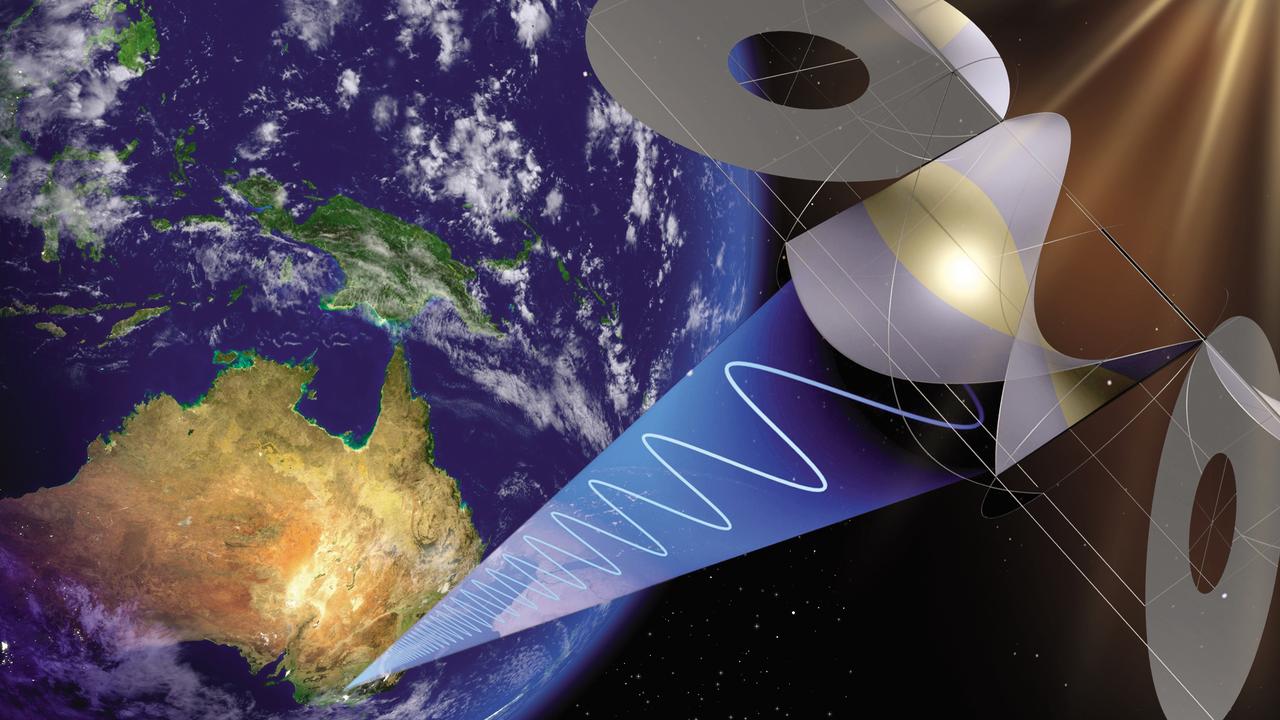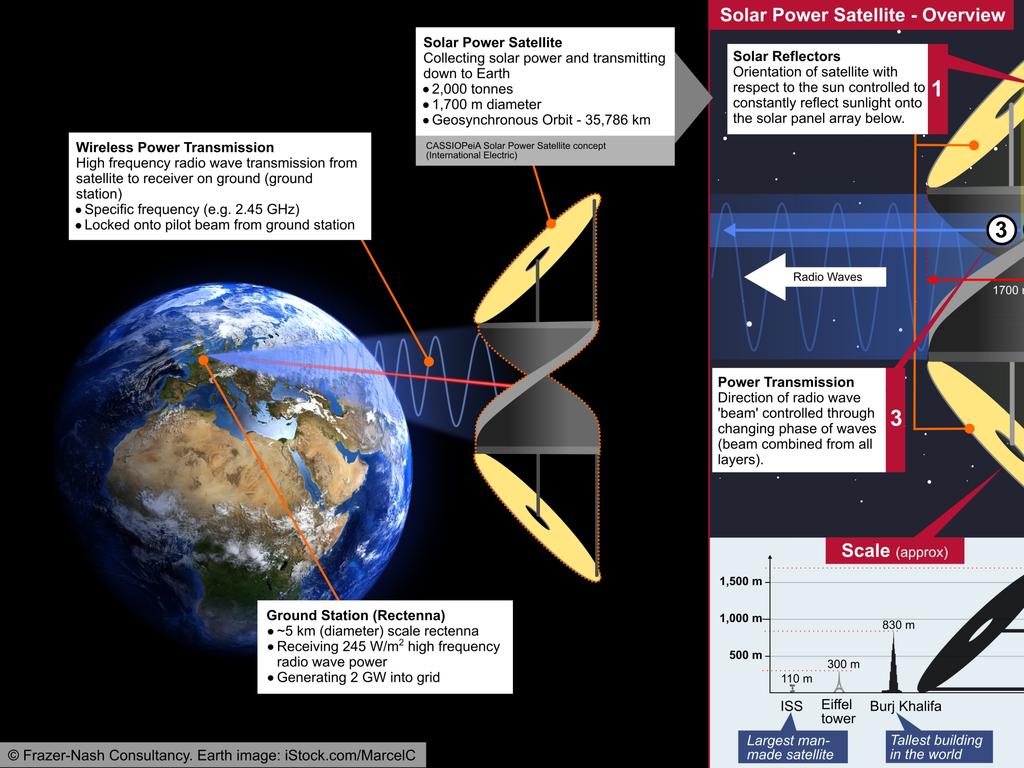Australia joins UK to assess idea of generating solar power in orbit
The idea might seem ‘out of this world’ but Australia and Britain are in talks about building a solar power station in space to lower power bills and help the two nations reach net zero emissions

READING LEVEL: ORANGE
It’s an idea out of this world – literally.
Australia and Britain are in talks to build a giant commercial* power station in orbit that beams down solar power to Earth, giving both countries sovereign* energy capability that will help slash utility* bills for households.
The British government has sought the interest of NSW, Victoria, South Australia, Queensland and Western Australia at a meeting with international consultancy firm Frazer-Nash to build a two gigawatt solar power station in space.

The vision is for its rotating satellites to collect sunlight, convert it to power and send it down to Earth to be fed into the power grid.
If given the go-ahead early next year, the space-based solar power initiative would help the UK and Australia work towards reaching net zero emissions*.
“This will help continuing relations between England and Australia, which have always held a special relationship, and give both countries sovereign capability on energy and not worry about fluctuations* in energy prices,” said London-based Australian engineer James Bunn, who negotiated the meeting several weeks ago.

“A briefing was held to assess the feasibility* of bringing electricity from space to the UK and Australia,” he said.
“By becoming self-sufficient, the UK and Australia can use the electricity supply chains to dictate their own energy prices to the consumer.
“This also eliminates the problem of relying on ground-based solar panels because in space there is no night-time, and by generating electricity all night long, we can maintain base load energy 24 hours a day.”
The race for net zero will see Australian and British officials attend a top-level meeting next month of European science ministers in Paris that will decide priorities for the European Space Agency (ESA), of which the UK is a member.
On the list for discussion is a proposal for testing the feasibility of a commercial power station in orbit.

Satellite solar panels gather up to 40 per cent more energy than fixed conventional* panels on Earth.
The space-based energy concept uses giant reflectors in orbit to take in the sun’s rays and points to potentially unlimited electricity, no carbon footprint* and more energy captured in a year than the total ever provided by fossil fuels and nuclear power.
The space industry has always led solar power development. A year after Russia launched the battery-powered Sputnik 1 in 1957, the Americans unveiled the Vanguard 1 satellite in orbit generating power through solar energy.
The solar power scheme is also expected to contribute to a world in which electric cars using sustainable* renewable space solar power is the norm.

Dutch start-up Lightyear has launched its Lightyear 0 electrical car that has solar panels covering the roof, bonnet and boot so that it can be charged while driving.
The Lightyear 0 car has 5sq m of curved solar panels on its roof, bonnet and tailgate, which convert renewable solar energy into electric power for driving.
The car is powered by traditional electric charging and solar power, meaning people would be able to drive while simultaneously charging from sunlight.
The plan is to deliver the car, billed as “the world’s first production-ready vehicle”, in November at a cost of approximately AUD $387,000.
GLOSSARY
- commercial: any enterprise or exchange of goods and services for money
- sovereign: being completely independent and having complete authority
- utility: a basic household service like water, gas and electricity
- emissions: things like gas, heat and light that are put out into the air
- fluctuations: changes, shifts, variations in the amount of something
- feasibility: establishing how hard or easy, possible or reasonable it is to do something
- conventional: ordinary, established, regular, standard
- carbon footprint: total greenhouse gases generated, including carbon dioxide and methane
- sustainable: uses natural resources at a steady level unlikely to damage the environment
EXTRA READING
Astronauts instal new solar panels in space
It’s out with the old, in with the new
How to tackle the climate challenge
QUICK QUIZ
- The British government sought the interest of which Australian states for the plan?
- How many gigawatts are proposed for the solar power station in space?
- Satellite solar panels gather up to what percentage more energy than fixed panels on Earth?
- The Dutch Lightyear O electric car is expected to launch at what approximate cost?
- Where on the Lightyear O are the solar panels positioned?
LISTEN TO THIS STORY
CLASSROOM ACTIVITIES
1. Space solar power
The Kids News article highlights all the advantages of having a solar power station in space, but what do you think some of the disadvantages or costs of this project might be?
Disadvantages/costs of space solar power station:
–
–
–
–
–
Time: allow 15 minutes to complete this activity
Curriculum Links: English; Science; Personal and Social; Critical and Creative Thinking
2. Extension
At the top level meeting of European science ministers next month, what might some other priorities be for the European Space Agency that might take precedence over the power station proposal?
Time: allow 10 minutes to complete this activity
Curriculum Links: English; Science; Critical and Creative Thinking
VCOP ACTIVITY
1. Summarise the article
A summary is a brief statement of the main points of something. It does not usually include extra detail or elaborate on the main points.
Use the 5W & H model to help you find the key points of this article. Read the article carefully to locate who and what this article is about, and where, when, why and how this is happening. Once you have located this information in the article, use it to write a paragraph that summarises the article.
Time: allow 25 minutes to complete this activity
Curriculum Links: English, Science


